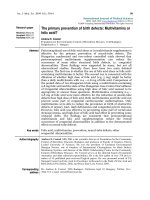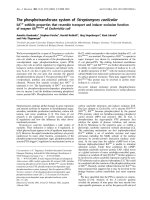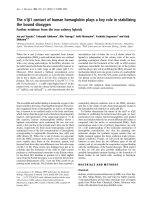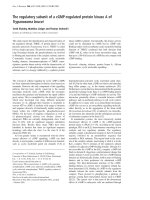Báo cáo y học: "The evolving story of medical emergency teams in quality improvement"
Bạn đang xem bản rút gọn của tài liệu. Xem và tải ngay bản đầy đủ của tài liệu tại đây (44.32 KB, 2 trang )
Available online />Page 1 of 2
(page number not for citation purposes)
Abstract
Adverse events affect approximately 3% to 12% of hospitalized
patients. At least a third, but as many as half, of such events are
considered preventable. Detection of these events requires
investments of time and money. A report in a recent issue of
Critical Care used the medical emergency team activation as a
trigger to perform a prospective standardized evaluation of charts.
The authors observed that roughly one fourth of calls were related
to a preventable adverse event, which is comparable to the
previous literature. However, while previous studies relied on
retrospective chart reviews, this study introduced the novel
element of real-time characterization of events by the team at the
moment of consultation. This methodology captures important
opportunities for improvements in local care at a rate far higher
than routine incident-reporting systems, but without requiring
substantial investments of additional resources. Academic centers
are increasingly recognizing engagement in quality improvement as
a distinct career pathway. Involving such physicians in medical
emergency teams will likely facilitate the dual roles of these as a
clinical outreach arm of the intensive care unit and in identifying
problems in care and leading to strategies to reduce them.
Adverse events, defined as undesirable outcomes caused by
medical care rather than underlying disease processes, affect
approximately 3% to 12% of hospitalized patients. At least a
third, but as many as half, of such events are considered
preventable [1-3]. These estimates come from large national
studies based on chart reviews, in which nurses look for
‘flags’ or ‘triggers’ (for example, death or unplanned admis-
sion to an intensive care unit), and physician reviewers then
determine whether any adverse outcomes resulted primarily
from medical care. Studies that have used direct observation
or more active forms of surveillance have yielded higher rates
of adverse events [4,5]. All of these detection methods
require substantial investments of time and money. Moreover,
especially in the case of chart review, missing information often
limits the ability of reviewers to identify adverse events or judge
their preventability. Thus, an efficient method for identifying
adverse events which yielded sufficient clinical detail to guide
assessments of preventability and did not require substantial
investments of additional resources would represent a
potentially powerful quality improvement tool for hospitals.
As Iyengar and colleagues [1] report in a recent issue of
Critical Care, medical emergency teams (METs), known
widely in North America as rapid response teams, may
provide just such a method. The rationale for the development
of METs rose from observations that, in the majority of
patients, premonitory signs and symptoms of cardio-
pulmonary instability are often present hours before clinical
deterioration [6]. By encouraging early responses to patients
with these signs, METs would presumably prevent progres-
sion to cardiopulmonary arrest. While the evidence regarding
their success in improving patient outcomes remains
conflicting [7,8], METs likely achieve other benefits, such as
increasing nurse satisfaction and retention, and may also
identify specific quality improvement targets related to
recurring problems encountered [9].
By standardizing MET calls with added information on the
preactivation period and performing a physician review of all
cases after 1 week, Iyengar and colleagues [1] were able to
screen 65 MET calls over a 4-week period. They identified
23 adverse events, 16 of which were judged preventable –
most commonly, the failure to deliver appropriate treatment
for a known diagnosis. The increased effort required for the
study consisted of only a 5-minute debriefing to fill out the
standardized MET form on each patient and a weekly 1-hour
Commentary
The evolving story of medical emergency teams in quality
improvement
André Carlos Kajdacsy-Balla Amaral
1
and Kaveh G Shojania
2
1
Department of Critical Care Medicine, Sunnybrook Health Sciences Centre, University of Toronto, 2075 Bayview Avenue, Room D108, Toronto,
ON M4N 3M5, Canada
2
Department of Medicine, Sunnybrook Health Sciences Centre, University of Toronto Centre for Patient Safety, 2075 Bayview Avenue, Room H468,
Toronto, ON M4N 3M5, Canada
Corresponding author: André Carlos Kajdacsy-Balla Amaral,
Published: 12 October 2009 Critical Care 2009, 13:194 (doi:10.1186/cc8033)
This article is online at />© 2009 BioMed Central Ltd
See related research by Iyengar et al., />MET = medical emergency team.
Critical Care Vol 13 No 5 Amaral and Shojania
Page 2 of 2
(page number not for citation purposes)
meeting to review each case in order to identify clinical
deteriorations that had resulted primarily from problems in
antecedent care.
Two previous studies have similarly assessed MET calls as a
marker for adverse events but relied entirely on retrospective
chart review [10,11]. Reviews of all 364 MET responses over
an 8-month period in an academic hospital attributed 30% of
clinical deteriorations to medical errors, which were mostly
diagnostic or treatment errors [10]. Root cause analysis of
these cases identified 18 processes of care for quality
improvement. Another study focused on MET calls for post-
operative patients and judged 26% of events as definitely
preventable, with an additional 47% as potentially prevent-
able [11]. Thus, all three studies of MET calls as a means of
detecting problems with the quality of care have found that
approximately one quarter to one third of MET activations
involve safety or quality problems. For selected patient popula-
tions (such as postoperative patients), the proportion of MET
calls which reflects deficiencies in care may be even higher.
The present study introduced the novel element of real-time
characterization of events by the team at the moment of
consultation. This real-time assessment eliminates the
resource-intensive process of retrospective chart review
without requiring much effort from clinical personnel because
the clinical debriefing flows naturally from the chart review
that MET personnel perform to the providing of patient care.
This methodology does not replace the need for other forms
of adverse event detection (such as incident reporting [12])
as it will miss events that do not involve critical clinical
deteriorations (for example, many potentially catastrophic
‘near misses’). It will also fail to detect problems in units not
covered by METs (including the critical care unit itself). More
fundamentally, the ‘on-the-go’ chart review process is not
standardized. However, chart review processes, even for
major epidemiologic studies in patient safety, suffer from well-
known problems with inter-rater disagreement [13,14], and
there is no reason to expect the process used in the present
study to be less reproducible than the incident investigations
that hospitals currently routinely employ.
In summary, the methodology described by Iyengar and
colleagues [1] captures important opportunities for improve-
ments in local care at a rate far higher than routine incident-
reporting systems but without requiring substantial invest-
ments of additional resources. Moreover, the direct involve-
ment of clinicians in the detection of patient safety and
quality-of-care problems likely facilitates the crucial next step
in any process for detecting adverse events, namely
identifying and implementing strategies to decrease future
events. Opening channels of communication between differ-
ent multidisciplinary teams will also foster a culture of safety
and continual improvement, instead of the (still common)
avoidance of error disclosure and analysis.
Many academic centers are increasingly recognizing engage-
ment in quality improvement as a distinct career pathway
[15]. Involving such physicians in METs will likely facilitate the
dual roles of METs as a clinical outreach arm of the intensive
care unit and a more proactive quality improvement strategy
that systematically identifies problems in care and leads to
strategies to reduce them.
Competing interests
The authors declare that they have no competing interests.
References
1. Iyengar A, Baxter A, Forster AJ: Using Medical Emergency
Teams to detect preventable adverse events. Crit Care 2009,
13:R126-R130.
2. Baker GR, Norton PG, Flintoft V, Blais R, Brown A, Cox J, Etchells
E, Ghali WA, Hébert P, Majumdar SR, O’Beirne M, Palacios-Der-
flingher L, Reid RJ, Sheps S, Tamblyn R: The Canadian Adverse
Events Study: the incidence of adverse events among hospi-
tal patients in Canada. CMAJ 2004, 170:1678-1686.
3. Committee on Quality of Health Care in America, Institute of Medi-
cine: To Err Is Human: Building a Safer Health System. Edited by
Kohn LT, Corrigan JM, Donaldson MS. Washington, DC: National
Academies Press; 2000.
4. Andrews LB, Stocking C, Krizek T, Gottlieb L, Krizek C, Vargish T,
Siegler M: An alternative strategy for studying adverse events
in medical care. Lancet 1997, 349:309-313.
5. Forster AJ, Kyeremanteng K, Hooper J, Shojania KG, van Wal-
raven C: The impact of adverse events in the intensive care
unit on hospital mortality and length of stay. BMC Health Serv
Res 2008, 8:259.
6. McQuillan P, Pilkington S, Allan A, Taylor B, Short A, Morgan G,
Nielsen M, Barrett D, Smith G, Collins CH: Confidential inquiry
into quality of care before admission to intensive care. BMJ
1998, 316:1853-1858.
7. Ranji SR, Auerbach AD, Hurd CJ, O’Rourke K, Shojania KG:
Effects of rapid response systems on clinical outcomes: sys-
tematic review and meta-analysis. J Hosp Med 2007, 2:422-
432.
8. Winters BD, Pham J, Pronovost PJ: Rapid response teams—
walk, don’t run. JAMA 2006, 296:1645-1647.
9. King E, Horvath R, Shulkin DJ: Establishing a rapid response
team (RRT) in an academic hospital: one year’s experience. J
Hosp Med 2006, 1:296-305.
10. Braithwaite RS, DeVita MA, Mahidhara R, Simmons RL, Stuart S,
Foraida M: Use of medical emergency team (MET) responses
to detect medical errors. Qual Saf Health Care 2004, 13:255-
259.
11. Kaplan LJ, Maerz LL, Schuster K, Lui F, Johnson D, Roesler D,
Luckianow G, Davis KA: Uncovering system errors using a
rapid response team: cross-coverage caught in the crossfire.
J Trauma 2009, 67:173-178.
12. Beckmann U, Bohringer C, Carless R, Gillies DM, Runciman WB,
Wu AW, Pronovost P: Evaluation of two methods for quality
improvement in intensive care: facilitated incident monitoring
and retrospective medical chart review. Crit Care Med 2003,
31:1006-1011.
13. Hayward RA, Hofer TP: Estimating hospital deaths due to
medical errors: preventability is in the eye of the reviewer.
JAMA 2001, 286:415-420.
14. Localio AR, Weaver SL, Landis JR, Lawthers AG, Brenhan TA,
Hebert L, Sharp TJ: Identifying adverse events caused by
medical care: degree of physician agreement in a retrospec-
tive chart review. Ann Intern Med 1996, 125:457-464.
15. Shojania KG, Levinson W: Clinicians in quality improvement: a
new career pathway in academic medicine. JAMA 2009, 301:
766-768.









